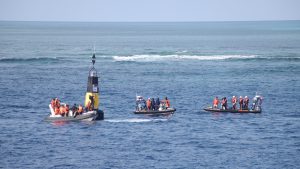The Philippines and the United States could launch joint patrols in the South China Sea before the end of this year, as tensions with China continue to intensify in disputed parts of the waterway.
In comments given to BenarNews, Jonathan Malaya, a spokesman for a Philippine task force on the South China Sea, said that discussions with Washington were “in their advanced stages” and that the patrols would begin “within this year.”
Back in February, Jay Tarriela, the Philippine Coast Guard (PCG)’s spokesperson on South China Sea issues, told the press that the two allies were in “ongoing talks” about the “possibility of joining the U.S. Coast Guard in a joint patrol” in what Manila terms the West Philippine Sea. It was reported at the time that Australian and Japanese forces might also take part in the patrols, which are aimed at pushing back against Chinese incursions into the Philippine waters.
While Malaya did not give further details about the timing of the Philippine-U.S. patrols, the announcement comes at a time of renewed friction in disputed waters. Last weekend, Manila accused China’s coast guard of blocking and shooting a water cannon at a Philippine military supply boat in the vicinity of Second Thomas Shoal.
The Chinese actions prompted strongly worded protests from both the PCG and the Armed Forces of the Philippines, and the summoning of Chinese ambassador Huang Xilian for a formal diplomatic protest. It also elicited strong condemnations from partners and allies of the Philippines, including the U.S., European Union, Japan, and other nations.
The Chinese intervention was designed to prevent the Philippine navy from resupplying marines stationed aboard the BRP Sierra Madre, a rusting World War II-era ship that was intentionally grounded in the shallow waters of Second Thomas Shoal in 1999. The shoal sits well within the Philippines’ Exclusive Economic Zone (EEZ), but China claims the feature under its maximalist “nine-dash line” claim, which cuts deeply into Manila’s EEZ and continental shelf.
Beijing responded to the Philippines’ protests by condemning in turn Manila’s “unlawful, provocative behavior” around Second Thomas Shoal, and said that it had “yet to fulfill” a promise to remove the Sierra Madre from the feature. President Ferdinand Marcos Jr.’s office immediately denied the country ever having made such a promise.
Back in February, the PCG accused a Chinese ship of using a military-grade laser at a Philippine vessel, once again in an attempt to prevent the resupply of the forces aboard the Sierra Madre.
If the plan materializes, it will be the first time the Philippines has joined multilateral maritime patrols in the South China Sea. The development reflects the rapid advance of U.S.-Philippine relations under President Marcos, after six years in which his predecessor Rodrigo Duterte spurned Washington, and leaned into stronger relations with China.
The Philippines’ participation in multilateral patrols would likely anger policymakers in Beijing and reinforce the reigning Chinese perception that the country is little more than a proxy for Washington. But such patrols would be a logical response to the repeated Chinese incursions into Philippine waters. If China’s government is unsettled by the development, it can only blame itself.

































